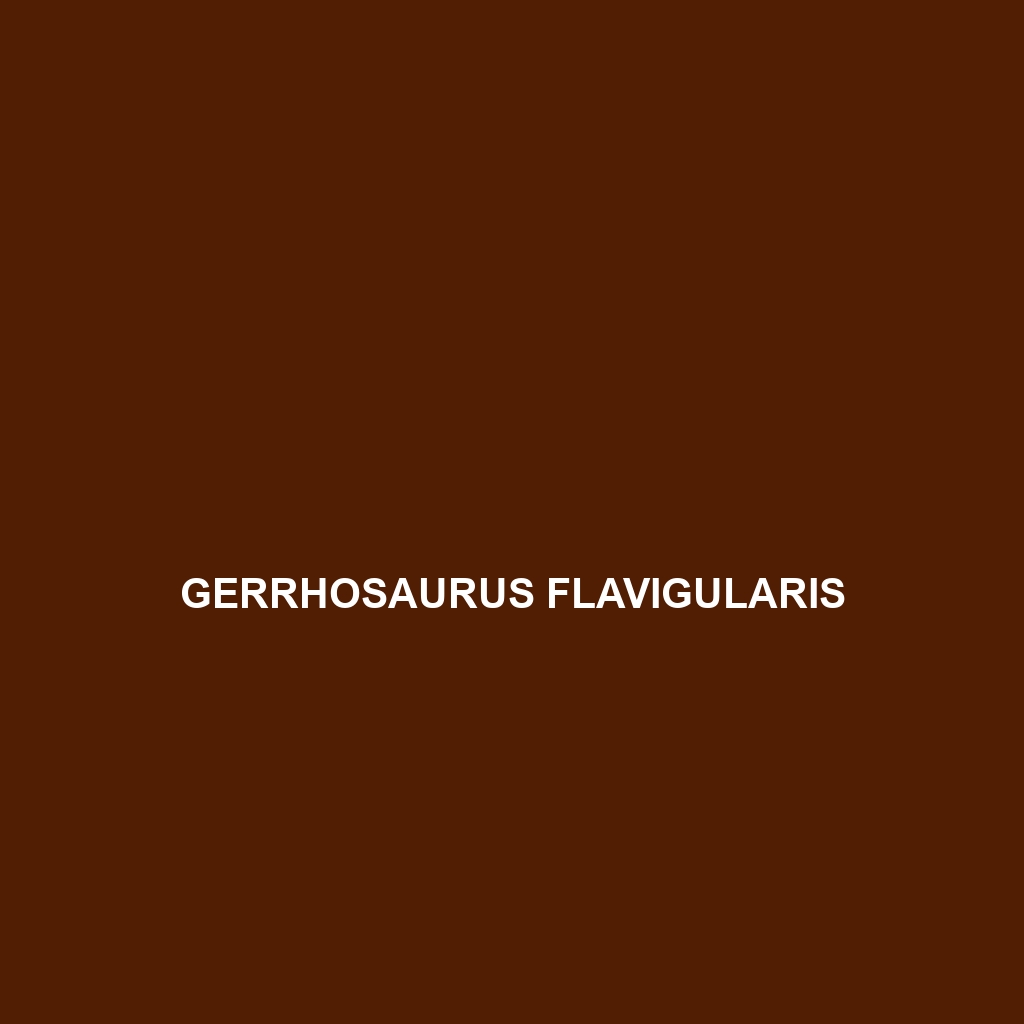Common Name
Gerrhosaurus flavigularis
Scientific Name
Gerrhosaurus flavigularis
Habitat
Gerrhosaurus flavigularis, commonly known as the yellow-throated plated lizard, primarily inhabits diverse environments across eastern and southern Africa. The species is predominantly found in savannas and grasslands, where the open landscape supports their foraging behavior. Additionally, they are also seen in temperate forests and occasionally in disturbed areas where vegetation is still present. The climate in these regions varies from subtropical to tropical, providing a suitable habitat characterized by moderate rainfall and warm temperatures. These lizards often seek refuge in soil burrows or under rocks, which offers them protection from both predators and extreme environmental conditions.
Physical Characteristics
Gerrhosaurus flavigularis exhibits distinct physical characteristics that make it easily recognizable. Typically, these lizards reach a size of approximately 20 to 30 centimeters in length. The most striking feature is their vibrant yellow throat, which contrasts with their generally brownish or grayish body color. This coloration serves as a camouflage against the sandy and earthy backgrounds of their habitats. Their bodies are elongated with a flattened appearance, equipped with a powerful tail that helps in balance and mobility. Notably, the species has a set of scaly plates along its back, which gives rise to its common name, the plated lizard, and contributes to its distinctive appearance.
Behavior
Gerrhosaurus flavigularis is primarily diurnal, engaging in most of its activities during daylight hours. These lizards are known for their territorial nature and can often be seen basking in the sun on rocks or tree roots. They exhibit a variety of social interactions, achieving a balance between solitary and communal living, particularly during the breeding season. Their mating rituals are fascinating; males engage in displays of dominance that include head-bobbing and color changes to attract females. Gerrhosaurus flavigularis also demonstrates a unique form of defensive behavior: when threatened, they may flee into burrows or exhibit a freeze response to avoid detection.
Diet
As primarily insectivores, Gerrhosaurus flavigularis feeds on a diet composed mainly of insects such as beetles, grasshoppers, and other small invertebrates. They have also been noted to consume vegetation occasionally, thus exhibiting omnivorous feeding habits. Their feeding patterns are characterized by foraging, where they actively search for food during the day. This enables them to maintain a balanced diet that supports their energy needs, particularly as they engage in their daily basking and social behaviors.
Reproduction
The reproductive cycle of Gerrhosaurus flavigularis begins with the arrival of the rainy season, which signals mating activities. During this time, males display courtship behaviors that entice females. Once mating occurs, the female lays a clutch of eggs, typically ranging from 5 to 15, in a hidden location such as soil or vegetation cover. The gestation period lasts between 60 to 90 days, after which the hatchlings emerge fully functional and ready to fend for themselves. Parental care is minimal, with the female typically leaving the eggs to incubate independently. The hatchlings are, however, well-equipped for survival, possessing the instincts to hide from predators immediately after birth.
Conservation Status
The conservation status of Gerrhosaurus flavigularis is currently listed as Least Concern by the IUCN Red List. This status is attributed to the species’ wide distribution and adaptation to varied habitats. However, some localized populations face threats due to habitat destruction, climate variability, and the impact of agricultural expansion. Conservation efforts are focused on habitat protection and management, ensuring that the environments in which they thrive remain viable for future generations.
Interesting Facts
One of the most intriguing aspects of Gerrhosaurus flavigularis is its remarkable ability to change color in response to temperature or mood, akin to some chameleons. This ability not only serves as a form of communication but also aids in thermoregulation. Furthermore, these lizards have an impressive longevity, with individuals living up to 15 years in the wild, making them a fascinating subject of study for herpetologists.
Role in Ecosystem
Gerrhosaurus flavigularis plays a significant role in its ecosystem, contributing to the control of insect populations through its diet, which makes it a vital insectivore in the food web. Additionally, as prey for larger predators, these plated lizards serve as an essential link in the ecological chain, supporting biodiversity. Their burrowing habits also enhance soil aeration, positively impacting the surrounding vegetation and contributing to the overall health of their habitats.
This structure and formatting provide an informative and engaging overview of the species Gerrhosaurus flavigularis, optimized for readability and search engine visibility.
